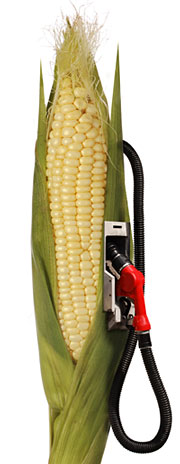
Future or folly?
Photo: iStockphoto
After spending much of the last several months thinking about the biofuels boom and its implications in preparation for this special series, we’ve come to a few conclusions.
Like other energy sources, biofuels have significant environmental liabilities. Boosters’ rhetoric about “renewable energy” aside, topsoil — from which biofuel feedstocks spring — is not an easily renewable resource. It takes centuries under natural conditions to replace an inch of topsoil lost to erosion. Lester Brown of the Earth Policy Institute reckons that “36 percent of the world’s cropland is now losing topsoil at a rate that is undermining its productivity.”
In the United States, corn-based ethanol amounts to 95 percent of biofuel production. Corn leeches nitrogen from the soil like no other major U.S. crop, drawing an annual cascade of synthetic fertilizer. Not only does this practice degrade soil structure, but fertilizer production also releases nitrous oxide, a greenhouse gas much more potent than carbon dioxide.
Moreover, often with the stated goal of reducing greenhouse-gas emissions, biodiesel producers are razing vast swaths of tropical rainforests — centers of biodiversity and natural sponges for greenhouse gases.
Any reasonable energy policy will account for and minimize biofuels’ real environmental footprint. What we’re seeing now, though, is a headlong rush into “green” energy with little thought about actual impacts.
The biofuel industry is dangerously concentrated. One reason for the gap between environmental rhetoric and performance might be that a few large companies exert tremendous control over the biofuel market. Archer Daniels Midland produces [PDF] a quarter of U.S. ethanol — about eight times the market share of its nearest rival — and is also the leading player in Europe’s growing biodiesel market.
As a result, it exerts tremendous leverage over the choice of feedstocks — and it chooses to use what’s cheapest and most plentiful (corn for ethanol, soy or palm for biodiesel), not what’s easiest on the environment. A deconsolidated biofuel industry, less historically invested in a single crop (as ADM is with corn), might lead to a broader variety of region-appropriate feedstocks.
U.S. biofuel policy is endlessly generous — and hopelessly incoherent. U.S. governmental institutions subsidize biofuel use in a dizzying variety of ways, with goodies lurking everywhere from local tax codes to the federal Energy Policy Act of 2005. Key lawmakers from both parties have signaled that the farm bill, up for renewal next year, will contain yet more ethanol incentives.
In a long study for the Geneva-based Global Studies Initiative designed to quantify U.S. public support for biofuel, Doug Koplow encountered [PDF] “hundreds of programs now in place to subsidize nearly every stage of the ethanol and biodiesel supply chains.” And there are more on the way: “The National Biodiesel Board, for example, notes that it is tracking more than 160 pieces of legislation at the state level for biodiesel alone.”
Koplow figures that these policies, which operate with zero coordination, will soon deliver upward of $6 billion annually in benefits to the biofuel industry. Clearly, before governmental bodies serve up yet more goodies, it’s time for a hardheaded balancing of costs and public (e.g., environmental) benefits.
Cellulosic ethanol should earn its governmental support. Ever promising, commercial-scale cellulosic ethanol remains years in the future. Cellulosic ethanol potentially makes sense because it could make use of non-food feedstocks grown on marginal land with minimal inputs — stuff like mixed prairie grasses.
As Koplow shows, subsidies for cellulosic ethanol are set to increase over the level currently enjoyed by conventional ethanol. Fine. But federal support should be specifically focused on turning non-food, low-impact crops into fuel. ADM has signaled its intention to use waste from the corn harvest as a principal source of cellulose. But that just means more soil erosion in the Corn Belt. Let the ethanol king use what it wants to — but turn off the taps of government largesse to producers who don’t use environmentally sound feedstocks.
Small is beautiful. The most promising biofuel developments we’ve come across are the small-scale, region-specific efforts of the type recently chronicled by Emily Gertz. These projects tend to focus on waste materials such as used vegetable oil, which would otherwise need to be disposed of. And they’re owned by their users, meaning that — unlike most of the energy economy — community concerns can profoundly affect the running of the businesses, and profits build local economies, rather than accruing to distant shareholders.
Conservation is still king. As Maywa Montenegro reported at the start of our series, even the most optimistic forecasts of how much fossil energy biofuels can replace rely on a serious conservation program. Maywa points to a 2004 Natural Resources Defense Council report that claims cellulosic ethanol can displace a huge chunk of gasoline by 2050. The catch: to achieve that goal, motor-fuel use must plunge.
NRDC reckons that if present trends continue, the U.S, will be burning 290 billion gallons of gasoline by 2050 (up from 140 billion gallons today). In order for even cellulosic ethanol to replace a significant chunk of gasoline consumption by then, we’ll have to push consumption down to the equivalent of 108 billion gallons of gasoline by 2050 — much less than half of where current trends are taking us. What NRDC is really promoting is an extremely ambitious conservation effort.
Today, the government and the dominant agribusinesses seem much more interested in boosting ethanol at any cost than in pushing conservation. That strikes us as precisely backward. If biofuels are used as a way to leverage conservation efforts, then we support them, with caveats; if they’re a way to distract from conservation efforts, as currently seems the case, then we say the hell with ’em. Conserve!

